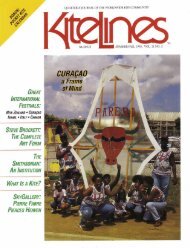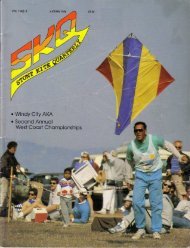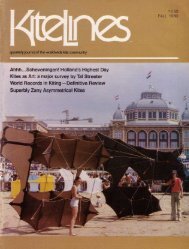much debate among the <strong>Kite</strong> <strong>Lines</strong>staff, and an imaginary debatewith John Spendlove, we decidedto print a version that incorporateshis concept but allows for morecategories and also a bit more leewaybetween them . For example,different types of kites, thoughthe same in their longest dimension,can vary decidedly in theirimpression of size . We hope publicationof this chart will stimulatediscussion and possible futurerefinement .ROBERT S . PRICEBurtonsville, MD . Physicist, leaderof the Maryland <strong>Kite</strong> Society andbuilder of large box kites .One system of classifying kitesis by manageability, and in thissystem there are two sizes of kite :one that a single person can managein most circumstances andone that requires more than oneperson . To manage a kite I meanto launch it, fly it and recover it .If the kite is sufficiently powerful,it can lift or drag the flier andthus become unmanageable . Myfeeling is that an 8-foot long boxkite is a comfortable size for oneperson to manage . A 16- or 18-foot wing-spread delta is probablyalso in this class .Another system of classifyingkite size is by structure. One categoryof kites would include thosekites made with simple, solid sticksof common wood . Another categorywould include those withhollow wooden or bamboo spars .There are kites with exotic materialspars-aluminum tubing, fiberglass,etc. Of course, there aresparless kites, too, such as theParafoil .The main reasons for buildingkites larger than one person canhandle are to make the flyingoperation a cooperative, teamaffair, to develop lift for a specialoperation (such as a man-lift), orto make the kite visible at a greatdistance .The lift goes up as the square ofa linear scale factor while the requiredsection modulus of thecompressive members goes up asthe cube of the scale factor . ThisBob Price showing off one of his elegant hollow-spar boxis why hollow spars become desirablein larger rigid kites .I don't see why there is any particularlimit to the size of a kitethat could be made to fly-it isjust that landing and launchingwould become very difficult . It ismore reasonable to fly en-trainusing smaller kites .RICHARD S . ROBERTSONAustin, TX. Leading Texas kiterand the father in a family of sevenactive kiters .I would really have missed anenjoyable phase of kiting if Ihadn't made large kites . Making alarge kite that will fly just as wellas a small one is a real challenge . Iremember some years ago when Imade an 18-foot turkey vultureaccording - to Hod Taylor's plans . Ientered it in the Largest <strong>Kite</strong> eventin our contest and it wasn't aslarge as some that were entered,but it flew as no other kite aroundcould fly . The wings flapped andthe kite found its flying positionand stayed there . The spectatorsenjoyed watching the vulture flymuch more than the kite that won .Flying a large kite is like catchinga big fish . The pull of the lineis both thrilling and challenging . Igenerally tie the line to a car, treeor backstop, but if the wind is notRichard Robertson's well-made eagle and centipede kites .kites.too strong, I just "hang on ."One of the thrills of a large kitelike my 100-foot centipede is theoverwhelming spectator interestand desire to participate . Ask foreight volunteers to help you launchit and you end up with 25 .ALBERT F . RIEDERERCornwells Heights, PA . Winner ofLargest <strong>Kite</strong> award at the GrandNational <strong>Kite</strong> Festival, Ocean City,MD, September 23, 1978 .What really got me into largekites was one year at the BenFranklin fly in Philadelphia . Somestudents from Drexel Universityhad a Bermuda kite made withhalf-inch pine bolted with 1/."bolts and with 60 to 80 feet oftail . It took up the entire quadrangle. I couldn't believe somethinglike this would fly . I decidednext year I had to fly a large kite .I had flown Eddys since I was sixyears old . A buddy and I got theDan Lirot plans for a 30-foot deltaand built it and flew it-and itreally got into our blood . Everytime I flew it it was as if it werefor the first time . It drew a crowdand it totally involved the children. You get a million kids aroundyou. I only spent $20 to $25 on itat the time .It's awe-inspiring . It does drawattention, it draws interest to thetotal love of kites . Also biggerkites are easier to fly once you getit together . But just the look ontheir faces is something to behold .You don't even look at the kite!You look at the spectators . That'sthe reward .EDWIN L . GRAUELRochester, NY. <strong>Kite</strong> designer andexperimenter .While I have always felt thatgiant kites made more sense thanvery tiny ones, I have never felt acompelling urge to spend muchtime on making or flying the monsters. The four big ones I havebuilt were made purely to determinehow large these kites couldgo and still be handled satisfactorilyby one person .But the interesting thing is thatonce these big fellows are in theair, they invariably attract moreattention and more discussionthan similar kites in smaller sizes .It has been my observation,both as a judge and as a competitor,that large kites almost invariablywin the prizes in most kitingcompetitions (except for thesmallest kite classification) . It'spretty tough to let the big kites,representing many hours of work,go away without a prize, evenwhen things aren't exactly equal .So, if a purpose of kite flying is towin awards, the larger the kite thebetter.There are at least two other advantagesin making and flying giantkites. First, the larger the kitethe more forgiving it is in over-
coming construction errors andpoor workmanship ; and, secondly,big kites make a fine group projectfor planning, constructionand flying .In summary, in my opinionthere is a time and place for giantkites for a limited group of kiteenthusiasts who are willing to putup with all the disadvantages inorder to achieve the unusual .RICK KINNAIRDLaurel, MD. Local kite personalityand Captain of Kinnaird's Cody<strong>Kite</strong> Crew .If you expect to win a contestwith a big kite-you will not . I believethat most judges are prejudicedagainst large kites becausethey don't understand them . Butyou win in the hearts and mindsof the spectators . You do it forthe glory-you can't be ignored!The problem is the judges scorelarge kites the same as they domuch smaller kites and your errorrate may be the same or less-inproportion . For example, a wavyseam isn't such bad workmanshipin a really large kite .When you're building a largekite, you spend a lot of time conceptualizingfinal details, the trimof the edges, etc . Once you set itup you find ways that work a loteasier . In some larger scales (myCody, for example) the kite fightsagainst itself. The problems aremagnified in relation to size . Youhave to solve the relation betweenvolume and surface area . If youtry to maintain the strength ofthe wood, the diameter increasestoo much .You've got to be in shape to flyit . I pulled a nerve (got "kite elbow"),putting strain on my shoulderand chest muscles . Use a pulleyand a strong, coordinated crew .One man alone is good, but there'sa chance you'll hurt yourself .CURTIS MARSHALLBaltimore, MD . Well-known physicianand designer of large kites .Monumental kites are not "better"than small kites, they aremerely different . Just as one personmay prefer a kite which is sostable that it appears to be nailedto the sky, another decries suchperformance and wants an "active"kite . The best kite size, then, isthat which pleases the builder andflier, but why does that relativelysmall minority prefer kites ofmonumental dimensions?The sky is a big place . It usuallyencompasses slightly less than halfof all one can see . When a kite isflown at sufficient height to beabove ground turbulence, it is apparentthat, at 200 feet, a fourfootkite appears almost lost inthis immensity. A large kite flyingat such an altitude offers more tothe appreciative eye .In addition, observers seem tobe impressed by sheer size alone .Rick Kinnaird and Carolyn Staples trim their Cody in a hotel room .Often heard is an exclamationthat it is "bigger than I am ." Formost of us who build kites, knowledgethat others appreciate oureffort constitutes a large portionof whatever rewards are realized .The builder of large kites alsofeels the "bigger than I am" awefor his own creation . An additionalreward is his appreciation that thekite is a worthy adversary whosestrength is pitted against his own .Although the pull of the kite maywell be such that it could draghim along as the wind speed rises,one hopes his intelligence will exceedthat of a nonsentient kite sothat he will remain in control .The effort one expends in the fatiguingoperation of landing a largekite may easily satisfy or even exceedhis daily requirements forexercise. It can also satisfy allmembers of a team in that alltheir physical efforts are neededto withstand the pull on the line .A large kite is to be distinguishedfrom a kite train ; even though theaggregate area and generated pullof the train may be great, a trainis still not a monumental kite .Curtis Marshall, aided by Rick Kinnaird, readies one of his giants .However, there can be a fine lineof distinction when one considerscertain articulated kites .I like to look upon kite size, notin terms of actual sail area, but interms of whether it can be flownby a child, a single adult or a team .The latter category, of course,could also be one person, aidedby a power winch or even a carand pulleys .With the increasing interest inthe use of kites to lift payloads,including cameras, thermometersand wind-speed measuring devices,as well as wind-powered lamps,there has been an associated movetoward increasingly larger kites .A large kite, when simply scaledup from a small kite, flies in analtered manner. The greater thesize, the more obvious the difference. This alteration in flight characteristicsresults from two predominantbut interrelated factors .First, the inertia of the mass ofthe frame and the sail cause aslowing of the movement of thekite and create a kind of majesticserenity . This slowing is perhapsmost apparent in kites which entrapa mass of air which then addsto the effective mass of the kite,such as the Parafoil . Second, alarge area of sail behaves in a differentmanner than does the smallarea in any given turbulence situation. The large kite reacts moreslowly and demonstrates an "averagingeffect" with regard tosmall areas of turbulence withinthe air mass . This difference is notreadily seen when a large kite anda small kite are flying togetherhigh in the sky, but becomes apparentwhen they are broughtdown into the ground turbulence .At this time, the sail of the largekite would be seen to ripple in responseto the air currents, whereasthese same air currents will tossthe small kite hither and thither .As to disadvantages, a large kitecan be exceedingly dangerous . Itcan injure the flier's hands, notonly with rope burns but also bysimple crushing action . It is usuallywise to use large diameter line inaddition to leather gloves for protection.One must remember that the kitecan easily rise from a low speedground wind into a high speedwind at a few hundred feet . Theaccompanying sudden increase indrag on a large kite can reversethe roles of "flier" and "flyee,"and the person who, a momentbefore, thought he was in control,can find himself dragged intobrush, off a dock or into traffic,to mention but a few unsavorypossibilities . It is always wise tohave a safety limit line attachedto a car or a tree . However, a lineunder heavy tension is very easilycut and a sharp edge on car trim,a fence pole corner or even astring from a small kite can part a1200-lb . test line in a fraction of asecond . The resulting "whip" ofthe suddenly freed heavy line canbe quite injurious .The crash of a large kite is potentiallydangerous as frame piecescan fly off even if an observer issufficiently alert and agile to escapea direct hit . From this pointof view, a large Parafoil is harmless,but any large kite can injurea bystander if a crosswind catchesit when the line is still at a lowangle and sweeps it across an area .To guard against this unpleasantoccurrence, it is wise to allow thekite to rise to a high angle with ashort line, and then to pay outthe line far above the heads of theonlookers .Another dangerous aspect offlying large kites derives from thepossibility of a frame memberbreaking loose and falling like ajavelin . This is not an uncommonoccurrence with experimental designsbut relatively rare when oneflies a proven kite design .With small kites, one tends to ignorethe specific patterns of stressin the frame and in the sail . Thisis justifiable in that the stresses
















